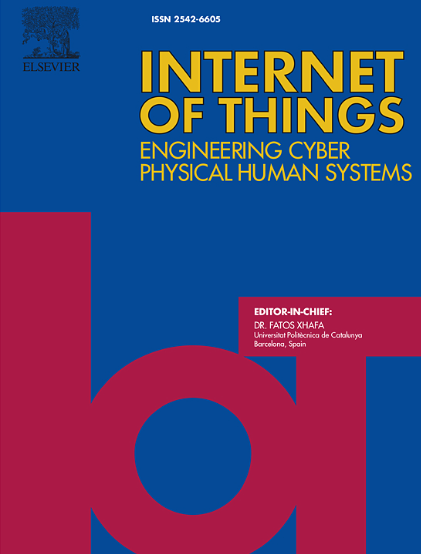一种有效的无线生物传感器网络复合故障检测与分类方法
IF 6
3区 计算机科学
Q1 COMPUTER SCIENCE, INFORMATION SYSTEMS
引用次数: 0
摘要
可靠性是无线生物传感器网络的一个重要方面。在此背景下,提出了一种有效的复合故障场景下无线生物传感器网络故障诊断方法。该方法包括三个步骤:首先,利用超时响应和Fletcher校验和实现敏感和非敏感区域的硬故障检测;其次,利用Z-score检验生成故障状态,进行软故障检测;最后,利用概率神经网络对故障进行分类,根据故障行为对复合故障进行分类。所提出的方法特别适合于无线生物传感器网络中的关键事件。在生物传感器网络仿真设置中实现了硬故障检测,并从故障检测前后的数据包传输率和能耗两方面对其性能进行了评估。对于硬故障检测,所提出的方法将数据包的投递率提高了~ 13.04%,同时在敏感区域将能耗降低了~ 11.96%。在非敏感区域,平均生物传感器节点和链路故障检测率为~ 87%。利用人体生物传感器数据和相关故障评估指标,通过仿真对软故障检测和分类进行评估。与现有方法相比,该方法将检测率提高了~ 8.81%,将假阳性率降低了~ 33.25%,将假阴性率降低了~ 43.25%。对于故障分类,永久性故障的检出率比其他故障高~ 4.68%,误分类率比其他故障低~ 45.09%。此外,在95%的置信水平上,对软故障检测和分类结果进行t评分,验证其统计显著性。实验结果表明,该方法能够有效地对复合故障场景进行检测和分类,与现有的故障诊断方法相比,具有更高的性能。本文章由计算机程序翻译,如有差异,请以英文原文为准。
An efficient methodology to composite fault detection and classification in wireless biosensor networks
Reliability is a critical aspect of wireless biosensor networks. In this context, an efficient methodology for fault diagnosis in wireless biosensor networks under composite fault scenarios is proposed. The methodology consists of three steps: firstly, hard fault detection in sensitive and non-sensitive regions using timeout response and Fletcher’s checksum implementation; secondly, soft fault detection through fault status generation using the Z-score test; and lastly, fault classification using a probabilistic neural network to categorize composite faults based on their behaviors. The proposed methodology is particularly well-suited for critical events in wireless biosensor networks. Hard fault detection is implemented in a biosensor network simulation setup, and its performance is evaluated in terms of packet delivery ratio and energy consumption, both before and after fault detection. For the hard fault detection, the proposed methodology improves the packet delivery ratio by 13.04% while reducing energy consumption by 11.96% in the sensitive region. In the non-sensitive region, the average biosensor node and link failure detection rate is 87%. Soft fault detection and classification are evaluated through simulations using human-body biosensor data and relevant fault evaluation metrics. Compared to its existing counterparts, the proposed methodology improves the detection rate by 8.81%, reduces the false positive rate by 33.25%, and reduces the false negative rate by 43.25%. For fault classification, the detection rate for permanent faults is 4.68% higher, and the misclassification rate is 45.09% lower as compared to other fault types. In addition, a T-score is performed to validate the statistical significance of the soft fault detection and classification results at a 95% confidence level. Experimental results demonstrate that the proposed methodology effectively detects and classifies composite fault scenarios, achieving superior performance compared to existing fault diagnosis methods.
求助全文
通过发布文献求助,成功后即可免费获取论文全文。
去求助
来源期刊

Internet of Things
Multiple-
CiteScore
3.60
自引率
5.10%
发文量
115
审稿时长
37 days
期刊介绍:
Internet of Things; Engineering Cyber Physical Human Systems is a comprehensive journal encouraging cross collaboration between researchers, engineers and practitioners in the field of IoT & Cyber Physical Human Systems. The journal offers a unique platform to exchange scientific information on the entire breadth of technology, science, and societal applications of the IoT.
The journal will place a high priority on timely publication, and provide a home for high quality.
Furthermore, IOT is interested in publishing topical Special Issues on any aspect of IOT.
 求助内容:
求助内容: 应助结果提醒方式:
应助结果提醒方式:


